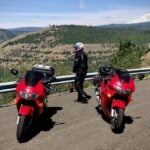Ted Compares/Contrasts Helmets In Different Price Ranges
Motorcycling can be expensive. Being exposed to the elements requires purchasing protective gear: a jacket, gloves, pants, boots and above all, a good helmet.
With a flood of helmets on the market ranging from under $50 to over $1,000, it is tempting to save money by buying a cheap lid. Beginning and veteran riders often ask: What’s the difference? Why do some helmets cost under a hundred bucks and others almost a thousand? Don’t they all have a DOT sticker? Won’t they all protect your head the same?
No, they are not the same. Yes, they are all round and have a DOT or sometimes a Snell sticker, but to say they are all the same is like saying that all automobiles are the same because they all have four wheels. Helmets of different prices have major differences, obvious and hidden, even if they are from the same manufacturer. A premium helmet fits, protects and functions better. Want proof? Read on.
For this comparison I am using two Bell helmets: the Bell Race Star Flex and the (now discontinued) Bell Vortex. Comparing two helmets from the same manufacturer in different price ranges is the best side by side comparison I can think of. Both are my personal helmets and neither were provided to me by Bell.
The Bell Race Star Flex retails for $779.95 and starts on the outside with a carbon fiber shell that trims the helmets weight to 1657 grams or 3.65 pounds (note: other reviewers have consistently measured weights of 3.35 pounds to 3.5 pounds. I am not sure why my personal model is heavier. Accumulated sweat maybe?) Picking it up, it feels quite light. To keep it as light as possible, Bell makes it in 5 different shell sizes, each with a specifically sized liner. Most manufactures make only 3 different shell sizes and make up the extra space with thicker or thinner liners, but Bell builds each shell size individually for each size head, for small through XL sizes. This way, you are not a medium head size carrying around the weight of a large helmet shell with the space taken up sloppily with extra padding. This means your helmet fits as close to your head as possible with minimum weight.
Beneath that are three separate impact layers with different densities to manage low, medium and high speed impacts. It starts with the layer closest to the shell made of EPS (expanded polystyrene) for high speed impacts. Next is EPO (expanded polyolefin) as a middle layer that is colored red and manages slow speed impacts, followed by EPP (expanded polypropylene) closest to the head for medium speed impacts. Having three independent layers also allows the layers to slip around each other to dissipate rotational energy from angular impacts.
The liner next to your skin is what Bell calls CoolJadeTM technology where recycled jade is fused into the fabric for a cooling effect that Bell claims can keep you up to 10 degrees cooler. As an added safety feature, the magnetic cheek pads can be removed downward by a first responder with the helmet still on your head.
This liner combined with two massive direct-to-skin chin vents, brow vents and exit ports in the rear make this a good warm weather helmet. But all of this venting does make this helmet slightly on the noisy side. Nothing a set of earplugs can’t solve. Or maybe I should get quieter bike.
Bell Race Star Flex
The cutouts at the bottom of the helmet visor (directly above the Ace Cafe logo) might look small, but make over the shoulder vision checks much easier. After all, that’s where your competition should be. Eyeport opening is massive and shield locks in place with the tab at the bottom of the faceshield. Pivot point on the faceshield moves rearward upon closing to draw the faceshield back toward the helmet making a tight seal.
The Race Star Flex has a Panovision faceshield, meaning extended viewing to the top and cutouts on the bottom right and left of the helmet to facilitate head checks over the shoulder. Removing it is crazy easy: just click the button on the side of the faceshield and it pops off. But what I like best about it is when it is shut, it is SHUT. Putting the faceshield down and locking it in place with the front tab sounds like closing the door on a gun safe. However, it is either fully up or fully shut, no detents in between.
The aerodynamic design can be worn in an upright, 3/4 or full tuck position and at speed, the helmet never lifts or buffets. It’s comfortable enough to wear every day and protective and aerodynamic enough to take to the track. Brad Binder, new rider for the MotoGP Tech3 KTM team, wears one. Point made.
Bell Vortex
Fit, finish and graphics on both helmets are exemplary. Even though carbon fiber is cool, I dearly love the Flying Tiger graphics. Air does not get replaced behind the helmet as smoothly as on the Race Star, increasing buffeting. Vertical “whistles” above and to the left of the Bell logo make a sound like a 3rd grader on a recorder playing Hot Cross Buns.
By comparison, the Bell Vortex cost $179.99 when produced and has been my trusty helmet for tens of thousands of miles and many years. It is no longer in production, but the Bell RS2 at $199.95 is comparable. The Bell Vortex is heavier at 1792 grams (3.95 pounds) with a polycarbonate shell and a single density liner with none of the multiple liner technology of the Race Star Flex. Three shell sizes are available with different sized interior padding to take up the extra space. Anti-microbial properties are built into the liner to defeat sweaty helmet funk and they click out of and into place easily for cleaning (or a roadside dunk in cool water for hot days) but unlike the Race Star Flex, the cheek pads cannot be removed with the helmet on.
The ClickRelease faceshield has decent vision and is likely the easiest faceshield removal design in the industry: push down on a tab on either side and the faceshield pops off. I can swap a faceshield in under 15 seconds while blindfolded. The ratcheting system has 15 detents giving multiple choices for opening but when shut, lacks the positive seal on the Race Star Flex. It doesn’t have the same wide opening and the Race Star so by comparison, vision is a bit more limited.
I have taken this helmet to the track and at speed it lifts and buffets slightly. And it is painfully loud. The direct chin and brow vents give fantastic airflow, but two of the exit vents on the back are vertical slits, just like whistles.
And whistle they do. I ride with clear tape over them (keen eyes will spot them in the photos) to defeat the whistle which also defeats their purpose of exiting warm air out the back but otherwise, even with earplugs, this is one loud helmet. Or maybe I should get a quieter bike.
So what does the extra $580 get you? Modern carbon fiber materials, lighter weight, near custom fit, better vision, advanced aerodynamics, protection against impacts of every speed including rotational and every bit of tech Bell can throw at it.
The Bell Vortex is not a bad helmet. I have worn it though every riding scenario you can think of from cafe runs and 500 mile days to track days, from sub-freezing temps to 109 degree desert speed runs. For the level of fit, finish and protection it gave at $179.99, it was a bargain in its day. However, when held next to a premium helmet, the benefits of the extra money spent are clear.
Bell Helmets
Keen eyes will notice the scrape on the back of the Race Star’s exit fin and the replacement black exit vent on the Vortex, proof that these helmets have been tested, maybe a bit too thoroughly. I know that the exit vents on the Vortex come off on impact, and I suspect the aerodynamic wing on the Race Star does also, but I have (thankfully) yet to test this.
But the best benefit of the premium helmet is it makes you want to ride. Unlike a cheap helmet that is heavy, loud, wobbles and makes you re-think that after work or week-long ride, the Bell Race Star Flex makes you want to ride. You want to grab it, put it on and take it for a spin. You will ride longer, more comfortably, less fatigued and better protected in the more expensive helmet.
And any piece of gear that makes you want to ride more is worth every penny.
Ted



































The problem I have is sizing. I have searched for a premium helmet and really like the Schuberth helmets, however I need a 5x and the only manufacturer I could find that makes a comfortable fitting helmet was HJC.
It’s on the heavy side but I really don’t have much of a choice.
It’s too bad more helmet makers do not have special order lids for customers with special requirements.
That’s a good point, David. Made-to-order, truly custom-fit helmets would meet many needs, for sure.